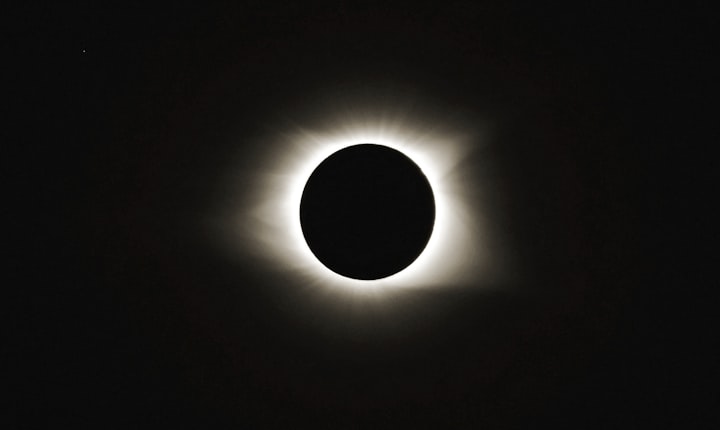Eclipses: Cosmic Spectacles of Nature's Grandeur
A Cosmic Ballet of Shadows and Light

Eclipses are rare, a sight to behold,
A cosmic ballet of the moon and sun, so bold,
Two celestial bodies in a dance profound,
Their alignment creates a spectacle renowned.
Lights out, darkness reigns, a celestial show,
As the moon obscures the sun's radiant glow,
In awe, we watch as the shadows grow,
Transforming day into an eerie, twilight tableau.
Putting on a spectacular display,
Nature's grandeur unfolds in a mystical way,
Spectators cheer as night becomes day,
In the fleeting moments of this cosmic play.
Eclipses, a reminder of nature's might,
A mesmerizing fusion of darkness and light,
A brief encounter that leaves us in awe,
As the moon and sun continue their celestial draw.
Eclipses have captivated human imagination for millennia. These rare celestial events, where the moon and sun perform their intricate cosmic ballet, are nothing short of mesmerizing. As the moon's shadow dances across the sun, a profound transformation occurs in the sky, plunging the world into temporary darkness. It is a spectacle that unites observers worldwide, evoking a sense of wonder and reverence for the vastness and beauty of our universe.
The journey of an eclipse begins long before it graces our skies. Astronomers meticulously calculate the paths of these phenomena, predicting their occurrences with astonishing accuracy. These predictions fuel anticipation and excitement among sky gazers, who eagerly await the rare opportunity to witness nature's grandeur unfold.
When the day of an eclipse arrives, a palpable sense of anticipation fills the air. Observers gather in designated viewing areas, armed with specialized eyewear and telescopes, ready to witness the cosmic spectacle. As the moon slowly creeps across the face of the sun, a hush falls over the crowd. The world seems to hold its breath as the first signs of the eclipse appear.
The initial phase, known as the partial eclipse, is a delicate dance of light and shadow. The sun's brilliance dims as the moon's silhouette encroaches, creating a surreal twilight ambiance. Birds quiet their songs, and the temperature subtly drops, signaling the onset of a celestial transformation.
As the eclipse progresses, the sky undergoes a dramatic metamorphosis. The moon's shadow advances, casting an eerie darkness over the landscape. Day turns to night in a matter of moments, as if time itself has been suspended. It is a sensory experience unlike any other, where the laws of nature momentarily falter, and the extraordinary becomes ordinary.
In the midst of this cosmic drama, observers are treated to a spectacle of celestial proportions. The sun's corona, a halo of shimmering light, bursts forth from behind the moon, creating a breathtaking sight. Wisps of solar material extend into the sky, painting a mesmerizing portrait of our star's hidden beauty. It is a sight that defies description, a fleeting moment of cosmic revelation.
But eclipses are more than just visual marvels; they are reminders of nature's might and precision. The intricate alignment of the sun, moon, and Earth showcases the delicate balance that governs our solar system. It is a reminder of our place in the cosmos, a humbling experience that fosters a deep appreciation for the wonders of the universe.
Throughout history, eclipses have held cultural and spiritual significance for diverse societies. Ancient civilizations viewed them as omens or celestial battles between gods. In modern times, they serve as opportunities for scientific exploration and public engagement with astronomy. Eclipses bridge the gap between scientific inquiry and human curiosity, uniting people of all backgrounds in a shared awe of the cosmos.
As the eclipse reaches its peak, a collective sense of awe washes over the spectators. Applause and gasps of amazement fill the air as the moon's shadow reaches its zenith. It is a moment of unity, where differences fade away in the face of nature's majesty.
Slowly but surely, the eclipse begins to wane. The moon's shadow retreats, relinquishing its hold on the sun. Daylight returns, casting a warm glow on the landscape. The world resumes its normal rhythm, but the memory of the eclipse lingers, etched in the minds of all who witnessed it.
In the aftermath of an eclipse, discussions abound. Scientists analyze data collected during the event, unraveling new mysteries of the sun and moon. Sky watchers share their experiences, recounting the beauty and wonder they beheld. Eclipses spark conversations about astronomy, physics, and the awe-inspiring nature of our universe.
As the final moments of totality fade, a sense of gratitude fills the hearts of observers. They have witnessed a celestial event that transcends words—a reminder of the interconnectedness of all things and the boundless mysteries that await discovery in the cosmos.
Eclipses, with their cosmic ballet of shadows and light, leave an indelible mark on those fortunate enough to witness them. They are reminders of our place in the vast expanse of space, urging us to look skyward and marvel at the wonders that surround us.





Comments
There are no comments for this story
Be the first to respond and start the conversation.